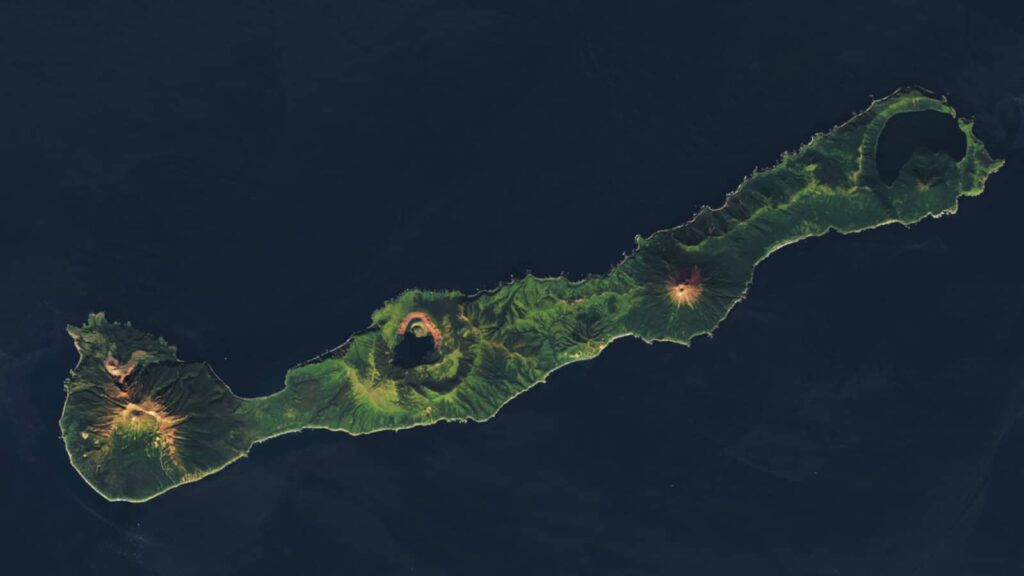In the 1830s, an inexplicable atmospheric phenomenon puzzled Europe and North America. The sun appeared in hues of blue and green, a persistent haze blanketed cities, and unusual weather patterns disrupted agriculture and brought a chilling climate. For nearly two hundred years, the origins of this anomaly remained an enigma.
Scientists long suspected a massive volcanic eruption as the cause, one that would have spewed sulfur into the atmosphere, cooling the Northern Hemisphere by almost a degree Celsius. Yet, the volcano’s identity and location eluded researchers—until recent discoveries shed light on this historical mystery.
The Unseen Culprit
Hidden in plain sight on Simushir Island, located in the remote Kuril archipelago between Japan and Russia, lies the answer. This island, once a strategic location for Soviet submarines, hosts four volcanoes: Milna, Zavaritski, Prevo, and Uratman. None have erupted in recent decades, but Zavaritski has now been identified as the likely source of the 1831 eruption.
“We had no idea this volcano was responsible [for the dramatic eruption],” said William Hutchison, a volcanologist at the University of St Andrews. “It was completely off the radar.” The findings were published in PNAS in December 2024.
Hutchison and his team identified microscopic volcanic glass shards, known as cryptotephra, in Greenland ice cores that matched ash deposits from Zavaritski. The chemical signatures were identical, confirming the volcano’s involvement.
“The moment in the lab when we analysed the two ashes together, one from the volcano and one from the ice core, was a genuine eureka moment,” Hutchison noted.
The Science Behind the Mystery
Volcanic eruptions of this magnitude release sulfur dioxide into the stratosphere, forming sulfate aerosols that reflect sunlight and lower surface temperatures. The 1831 event released an estimated 12 ± 3.5 teragrams of sulfur—surpassing the 1991 Mount Pinatubo eruption, which cooled the Earth by about 0.6°C.
Geochemical analysis ruled out other candidates like the Mediterranean island of Ferdinandea, as the isotopic fingerprints did not match the sulfur found in the ice cores. Instead, the evidence pointed to the northern reaches of the Kuril Islands and Zavaritski’s volcanic remnants.
While historical records are scarce due to Simushir’s sparse 19th-century population, consisting of Ainu, Russian settlers, and Aleuts, the eruption left a significant indirect impact on global climate patterns.
Unveiling the Impact
Dubbed Zav-1, this eruption was a forceful event. Researchers used radiocarbon dating and tephra thickness modeling to estimate its magnitude at 5.5 to 6, comparable to notable eruptions like Cosegüina in 1835 and Mount Pinatubo in 1991.
The eruption created a caldera still visible today, spreading ash and pumice to nearby islands. Its most profound impact, however, was felt far beyond, altering skies across the Northern Hemisphere.
Reports from August 1831 describe vividly colored skies and atmospheric phenomena such as Bishop’s rings. While some effects stemmed from Ferdinandea, the prolonged global cooling and famines align with the aerosol veil from Zavaritski.

Insights into the Past and Future
This discovery provides valuable insights for refining climate models that simulate volcanic activity’s impact on climate. It highlights the need for continuous monitoring of regions like the Kuril Islands, which remain under-observed in the Ring of Fire.
The identification of Zavaritski’s historical eruption invites further exploration of potential unrecorded eruptions that may have influenced our planet’s past and could affect its future climate stability.
Original Story at www.zmescience.com
